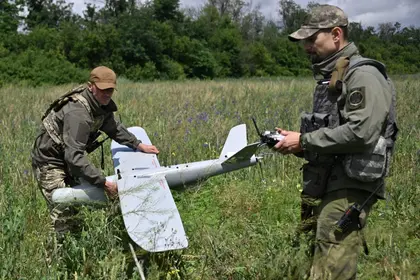Soldiers in eastern Ukraine swiftly unpacked a large grey drone and launched it to check the cloud level and survey the area, just kilometres from Russian positions.
The operators in the 45th brigade rely on Ukrainian-made reconnaissance drones to relay accurate information to their artillery, helping them to hit targets and conserve shells.
JOIN US ON TELEGRAM
Follow our coverage of the war on the @Kyivpost_official.
"It makes our work more precise," said one of the drone operators, Andriy, 31, whose call sign is "Ulysses".
"Our artillery, because of the need to economise shells, works in sniper mode," he added, meaning it has to be ultra-accurate.
"You can't afford to use a lot of shells on one target -- 3,4 or 5, not more -- because we do not have a lot of shells like the Russians have."
The Ukrainian drone sends data that can guide artillery. The operators watch on laptops in a van hidden under trees.
The team includes soldiers with fluent English and backgrounds in IT and marketing.
They boasted of artillery successes thanks to drones -- such as destroying four Russian Armata battle tanks in a single day.
Yet the cost of a drone, or an "unmanned aerial vehicle" (UAV) is high.
The unit's large Leleka-100 drone, which resembles a model plane, costs around 37,500 euros ($42,000), said Denys, 30, the head of the UAV squad.
A coffee-lover with the call sign "Hipster", Denys previously worked for a Ukrainian company that created a popular AI app.
The drone, made in an undisclosed location in Ukraine, streams video footage of targets and artillery hits.

‘If They Cut, I Think We Will Lose’ – Ukraine at War Update for Nov. 20
"It can fly even higher, but we use it at 1,000 metres (3,280 feet) because of the camera and the quality of pictures," Andriy said.
He added the drone is "medium" quality compared to Western models, but at least spare parts are easy to get from Ukrainian manufacturers.
Unlike small drones used by civilians, these larger drones can stay airborne for two or three hours.
But on average, each drone makes just 20 flights before it gets shot down.
- 'Baby' industry -
The men referred to their drones affectionately as "birdies".
Yet they are well aware the Russians have the advantage in this war of artillery.
Russia can afford to fire huge volleys of shells, and has also outpaced Ukraine in drone stocks and technology.
Moscow can launch huge numbers of cheap Iranian-made Shahed attack drones and expect at least one to hit the target, Andriy says.
It also makes Lancet tactical attack drones that are "quite effective in destroying Ukrainian artillery units," he says, while Ukraine does not produce any equivalent attack drones.
"Our industry tries, but still it's only trying, it still hasn't got enough experience," says Andriy.
"Right now we have lots of people who try to work from their garages... to make a UAV of their own," says Denys.
"Our UAV industry is like a baby," says Andriy.
"We have to invest in it to make it grow."
You can also highlight the text and press Ctrl + Enter






